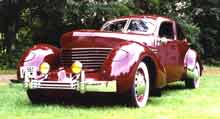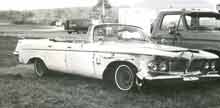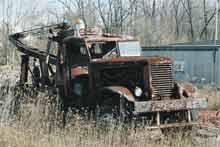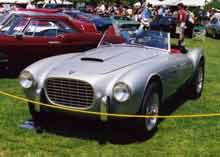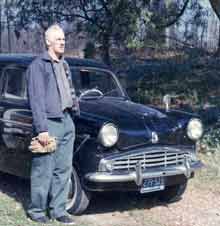A Cautionary Tale
It took my friend Dan Ditullio a little over twenty years to restore his Cord 812. The result is well worth the time and expense, but he learned a few things in the process, some stories worth retelling. This, friends, could happen to you.
He purchased the 1937 Beverly, the more upmarket of Cord's two sedan models, from a co-worker in the spring of 1981. The car looked better than it really was - it had been on the road in 1968, but the paint covered up a surfeit of poor body work done for some previous owner. The Cord doesn't have a frame, per se, so "body-off" doesn't apply. You have to hoist the whole car up and go in from underneath.
The car had experienced some fender damage, and in the process of fixing it one headlight had been installed higher than the other. It took Dan and his friend Charlie Reynolds quite some time to get the alignment just right. When finished, the Cord could say "peek-a-boo" without squinting.
Cord instrument panels are marvelous, an impressive array of instruments and airplane-type controls mounted on an engine-turned background. Dan's had suffered over the decades, so restoration was essential.
Dan had attended to his engine and re-installed it in the car. It sat for a while as the new interior and trim were installed. All restorers know that a dormant engine should be rotated periodically to keep its parts moving and lubricated. One day Dan began to do just that, cranking the engine with the starter with the spark plugs removed. A large dust cloud arose from one side, accompanied by a loud "crunch." Disassembly revealed the problem: mice had crawled up the exhaust pipe and stored seeds inside the engine. Cranking it over had punched the seeds clear through one of the aluminum cylinder heads.
All's well that ends well. A set of modern reproduction heads put the engine right, and patient finishing had the car ready for showing the next summer. It received a well-deserved "First Place Primary" at the 2002 Auburn Cord Duesenberg Festival in Auburn, Indiana. At this writing, the car has received a number of other awards, including a senior trophy at the 2004 ACD Festival, driven the 1,600 miles there and back while achieving about 20 mpg at 65 mph.
Dan's advice to fellow restorers: If you're going to let your engine sit for months, make sure you seal your exhaust pipe and carburetor intake tightly with duct tape!

